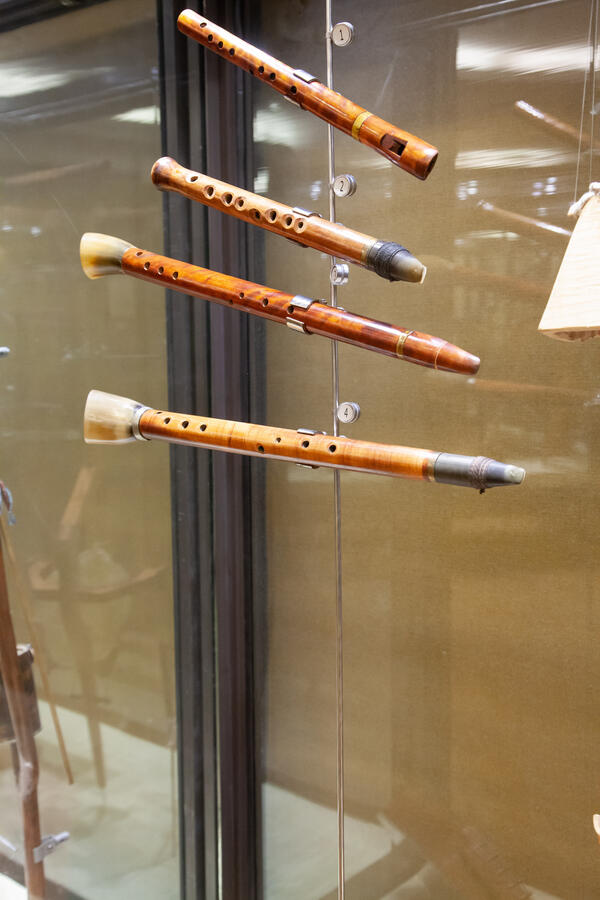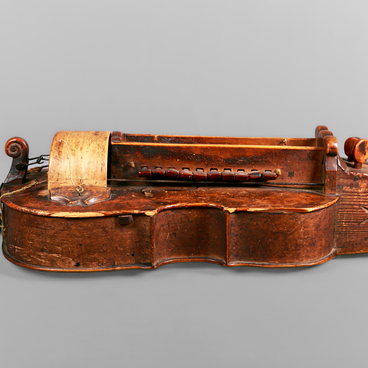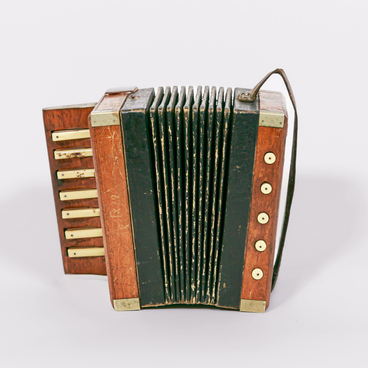The term birbyne is used to describe two types of shepherd’s wind instruments from Lithuania. Both of these variations are presented in the museum’s collection. One of them was made of thin cane. The reed was cut on the tube of the cane itself.
Another birbyne variation had a mouthpiece. Just like the orchestral clarinet, it had a single reed fastened to the mouthpiece. A flared bell was attached to the instrument’s low end — it was usually made of cow horn, and sometimes bark or wood.
Four, five, or six tone holes were cut in the body of traditional birbynes. This wind instrument has a very strong and clear sound. The birbyne was used to play dances and traditional multipart folk songs known as sutartines. This term comes from the Lithuanian word that means “to be in agreement.” Sutartines were performed at weddings and during work. In 2010, UNESCO included this type of music into its list of the Intangible Cultural Heritage of Humanity.
Birbyne players performed solo, in duets and trios, and also in ensembles with other instruments, mostly the violin and the accordion. In the past, the birbyne was a very widespread instrument, but its popularity started to fade away in the 19th century. However, by the end of the century, its design was improved based on classical instruments such as the clarinet. In the 20th century, the birbyne tradition experienced a revival.
The museum’s collection houses an improved birbyne with 11 tone holes. It has the inscription “Ansamblis Lietuva” which means that it was used by the State Academic Song and Dance Ensemble “Lietuva.”
“Lietuva” takes great pride in its orchestra which consists entirely of traditional Lithuanian instruments. These include several kanklės, which are string instruments similar to Russian gusli, and the skrabalai, an instrument consisting of wooden bells. Traditional wind instruments include the lamzdeliai pipe, the skuduciai pan pipe, and several birbynes that are mostly used to play the main melody.
Three different types of birbynes were designed by Lithuanian craftsmen for the wind section of the “Lietuva” orchestra, which differed in their pitch range: soprano, tenor, and contrabass.
Another birbyne variation had a mouthpiece. Just like the orchestral clarinet, it had a single reed fastened to the mouthpiece. A flared bell was attached to the instrument’s low end — it was usually made of cow horn, and sometimes bark or wood.
Four, five, or six tone holes were cut in the body of traditional birbynes. This wind instrument has a very strong and clear sound. The birbyne was used to play dances and traditional multipart folk songs known as sutartines. This term comes from the Lithuanian word that means “to be in agreement.” Sutartines were performed at weddings and during work. In 2010, UNESCO included this type of music into its list of the Intangible Cultural Heritage of Humanity.
Birbyne players performed solo, in duets and trios, and also in ensembles with other instruments, mostly the violin and the accordion. In the past, the birbyne was a very widespread instrument, but its popularity started to fade away in the 19th century. However, by the end of the century, its design was improved based on classical instruments such as the clarinet. In the 20th century, the birbyne tradition experienced a revival.
The museum’s collection houses an improved birbyne with 11 tone holes. It has the inscription “Ansamblis Lietuva” which means that it was used by the State Academic Song and Dance Ensemble “Lietuva.”
“Lietuva” takes great pride in its orchestra which consists entirely of traditional Lithuanian instruments. These include several kanklės, which are string instruments similar to Russian gusli, and the skrabalai, an instrument consisting of wooden bells. Traditional wind instruments include the lamzdeliai pipe, the skuduciai pan pipe, and several birbynes that are mostly used to play the main melody.
Three different types of birbynes were designed by Lithuanian craftsmen for the wind section of the “Lietuva” orchestra, which differed in their pitch range: soprano, tenor, and contrabass.






